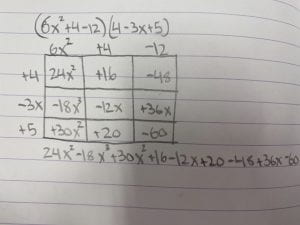This week we continued going through different ways to solve systems. Last week I talked about using substitution, but another way to solve a system is by using elimination.
With elimination you would have to make a zero pair, so make one term cancel out in each equation by making one negative and one positive. If one equation has for example a -2x and the other a 2x it’s easier, but if not then you would have to multiply everything by a number so that the terms would be the same but one negative and one positive, for example if you have -3x-3y=9 and 5x-3=y you would have to times everything by 5 in the first equation and everything by 3 in the second so that when you get -15x and 15x they would make a zero pair. The equations would now look like -> -15y=45 and -15=3y Then add the y’s and the numbers together -> -12y=30 -> 12y/12=30/12 -> y=5/2 …. And then you would continue finding the x with the known y and testing it to see if it works.
More examples:












 -> finding the y-intercept
-> finding the y-intercept -> finding the x-intercept
-> finding the x-intercept —-> Simplified answer= -18x^3+54x^2+24x-72
—-> Simplified answer= -18x^3+54x^2+24x-72